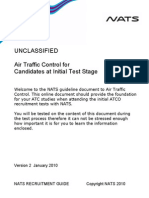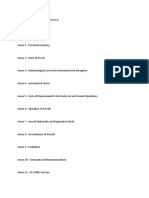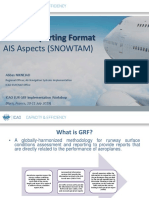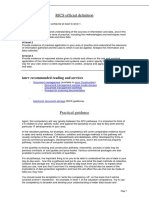065, G. Contissa Et Al., Automation and Liability in ATM As Fundamental Issues in Socio-Technical Systems
065, G. Contissa Et Al., Automation and Liability in ATM As Fundamental Issues in Socio-Technical Systems
Uploaded by
aliasnetworkCopyright:
Available Formats
065, G. Contissa Et Al., Automation and Liability in ATM As Fundamental Issues in Socio-Technical Systems
065, G. Contissa Et Al., Automation and Liability in ATM As Fundamental Issues in Socio-Technical Systems
Uploaded by
aliasnetworkOriginal Title
Copyright
Available Formats
Share this document
Did you find this document useful?
Is this content inappropriate?
Copyright:
Available Formats
065, G. Contissa Et Al., Automation and Liability in ATM As Fundamental Issues in Socio-Technical Systems
065, G. Contissa Et Al., Automation and Liability in ATM As Fundamental Issues in Socio-Technical Systems
Uploaded by
aliasnetworkCopyright:
Available Formats
Automation
and liability in ATM as fundamental issues in socio-technical systems
Giuseppe Contissa, Giovanni Sartor, Department of Law, European University Institute, Italy Matthias P. Finger, Andrea Rosa Robert Schuman Centre for Advanced Studies, European University Institute, Italy
ABSTRACT
SESAR is defining a new air traffic management system, with new technologies and high automation levels, for instance, systems that perform actions without explicit human intervention. Those will cause changes in the allocation of liability mainly on the operators. Some allocation issues, such as those concerning the relation between humans and automated systems, likely common in the future, are not contemplated in the current legal system. It is necessary to characterise to what extent new automatic tools may shift liability for accidents from operators to technology, namely from operators to manufacturers, organisations and system developers. Particular attention deserves the liability for software mistake, crucial for safety-critical systems, such as ATM. Additional layers of complexity are added by automatic and autonomous systems and hybrid man-machine units. This paper outlines the modeling framework that will be adopted in the ALIAS project (Addressing Liability Impact of Automated Systems), based on describing ATM as a socio-technical system. In such a system both technical and social aspects (humans and norms) are crucial for design and functioning, and the allocation of liabilities may be viewed as a governance-mechanism enabling the enhancement of the functioning of ATM. This will lead to the development of a methodological tool to support the introduction of any technology in complex systems, particularly in ATM, ensuring to take all the relevant legal aspects into consideration at the right stage of the design, development and deployment process. This work is co-financed by EUROCONTROL on behalf of the SESAR Joint Undertaking as part of Work Package E. Opinions expressed in this work reflect only the authors views and Eurocontrol shall not be considered liable for them. Keywords: Air Traffic Management, Automated Systems, Liability, socio-technical systems.
INTRODUCTION In the current operational scenario of ATM, liability is mainly allocated to the operators that are responsible for air traffic control and air navigation (e.g. controllers and pilots). However, this scenario will rapidly change: the SESAR concept of operations [1] is defining a new high-performance air traffic management system, involving the adoption of new technologies, devices, and high automation levels, which will enable the future development of air transport. Advances in automation and technology may bring about drastic changes from the legal and regulatory perspective, questioning the allocation of liability mainly on the operators. AUTOMATION AND LIABILITY The current legal framework in the ATM domain (see [2],[3],[4],[5]) despite involving the applicability of different models of liability (fault-liability, organisational liability, design liability), does not
contemplate the specific issues concerning the relation between humans and automated systems, which will become more and more relevant in the future of ATM: the issues, for instance, related to highly automated systems that perform actions without explicit human intervention, delegation procedures that dynamically transfer the responsibility from controllers to pilots or to other technical systems, functional airspace blocks involving new allocation of tasks. Such technological changes question the very notion of individual agency, and would demand a critical revision on the actual human contribution to the performance of ATM, and consequently, on the criteria for the allocation of liability. Several questions are prominent in this context. The first question refers to what extent the use of new automatic tools may shift liability for accidents from operators to technology, namely from operators to manufacturers, organisations and system developers. The second question concerns how to properly manage this shift in order to achieve an optimal allocation of liabilities. This will imply reconsidering the role of liability, not only as a tool to redistribute risks and allocate sanctions for errors and accidents, but also as a mean to prevent those accidents and to increase levels of safety and performances in ATM, fostering the development of a safety culture [18] within organizations. Thus, it will be essential 1) to identify tasks and roles of operators (managers, ATCOs, pilots, etc) and automated tools; 2) to identify level of expected performance for each task; 3) to consider different kinds of errors (unintentional rule violations, reckless behaviours, intentional violations); and 4) to define the appropriate legal and disciplinary sanctions and/or safety incentives in relation to different errors, risks and accidents [19]. A third question considers the extent to which the realisation of such a system requires a change of the law in force, the extent to which public regulation is required, or self-regulation, coupled with contractual mechanisms. Particular attention should be devoted to liability for software mistake. As it is well known (see for example [6],[7]), the use of software always implies the possibility of a failure. This is a crucial issue whenever software is the core component of a safety-critical system, such as those used in ATM. In these cases, assignment of responsibility is a problematic task [8], so that strict liability is usually imposed to the producer/manufacturer, in order to cover the necessity of assigning the risk to someone who would be considered to be in the best position to prevent defects in the
Giuseppe Contissa - European University Institute, Via delle Fontanelle 10, San Domenico di Fiesole, Italy, Tel: +39 055 4685 698, E-mail: giuseppe.contissa@eui.eu
2nd International Conference on Models and Technologies for Intelligent Transportation Systems 22-24 June, 2011, Leuven, Belgium
products, absorb or spread losses cases in which a person might be held responsible, even if no negligent action was performed. Automatic and autonomous systems add additional layers of complexity, since they may possess (in different degrees depending from the capabilities of each system) autonomous cognitive states and behaviours that are relevant from a legal perspective [9],[10]. Even further complexity may emerge when hybrid man-machine units are implemented: in these cases, agency does not pertain only to human or to machines, but to the hybrid itself [11], so that human machine interaction and trust play a decisive role in assessing and allocating liability. A MODELING FRAMEWORK FOR ATM An Air Traffic Management system can be viewed and described as a socio-technical system (STS), namely a system that involves a complex interaction between technical, social and organisational factors, as well as human factors [12],[13]. In STSs, both the technical and the social aspects (the latter including humans and norms) are crucial for their design and functioning: at the core of such systems is a technical infrastructure, designed to serve a specific purpose, coupled with human operators that continuously monitor and modify its state during the operational process. In the ALIAS project (Addressing Liability Impact of Automated Systems - recently started as part of SESAR Work Package E), we will focus on the legal implications of automation, exploring the relation between automation and liability in ATM as fundamental issues in humantechnology interaction. To reach these goals, we will address the issues of liability in ATM in the context of a socio-technical system, where the allocation of liabilities may be viewed as a governance-mechanism enabling the enhancement of the functioning of ATM. Thus, a comprehensive theory of ATM as a STS will be developed, so that it will integrate together: 1) an ontological model of ATM nature and structure, covering its technical, social and legal aspects; 2) a declarative model of ATM, based both on standard conceptual modelling languages (such as UML), and computational logic-based approaches suitable to deal with dynamic aspects of STS. ALIAS AND THE LEGAL CASE On the basis of the ontological and declarative models developed in the project, ALIAS will provide a methodological tool to support the introduction of any technology in complex systems, particularly in ATM, ensuring to take all the relevant legal aspects into consideration at the right stage of the design, development and deployment process. The methodological tool will be called Legal Case in analogy to the EUROCONTROL Safety Case [14] and Human Factors Case[15]. The tool will be useful
for those who need to understand how to behave in order to prevent accidents and avoid liabilities, and also for those who need to make inquiries on compliance and liabilities. It will include recommendations and guidelines, as well as a software application. In building such a system, we shall make use of the following ideas: 1) most recent theory of argumentation [16] will be used for building visual argumentation graphs, showing how exemption from liability results from compliance with all legal norms and technical requirements. We shall use argument schemas to categorise grounds for liability for different agents or exemptions from it; 2) recent AI work on arguments for automatic evaluation of argument graphs to establish whether all conditions have been fulfilled and in case who is going to be liable [17]; 3) embed in the graph appropriate links to source (according to established document standards), for accessing additional information, such as cases and guidelines; 4) embed in the graph information concerning burdens of proof, so that it may help in assessing liabilities when factual information is missing. This work is co-financed by EUROCONTROL on behalf of the SESAR Joint Undertaking as part of Work Package E. Opinions expressed in this work reflect only the authors views and Eurocontrol shall not be considered liable for them. REFERENCES
[1] SESAR Consortium (2008). The Concept of Operations at a glance. (http://www.eurocontrol.int/sesar/gallery/content/public/docs/Conc eptofOperations_02.pdf) [2] Diederiks-Verschoor I., Butler. M. (2006). An introduction to air law. Kluwer Law International, Alphen aan den Rijn. [3] Van Antwerpen N. (2008) Cross-border provision of air navigation services with specific reference to Europe: safeguarding transparent lines of responsibility and liability. Kluwer Law International, Alphen aan den Rijn. [4] M. Chatzipanagiotis. (2007). Liability aspects of air traffic services provision. Air and Space Law, 32, pp. 326357. [5] Leloudas G. (2009). Risk and Liability in Air Law. Informa Maritime and Transport, London. [6] Lanoue S. (1983) Computer Software and Strict Products Liability. San Diego Law Review 1983; 20(2), pp. 439-456. [7] Lawrence D.B.(1987). Strict Liability, Computer Software and Medicine: Public Policy at the Crossroads. Torts & Insurance Law Journal, 23(1): pp. 1-18. [8] Zollers F.E., McMullin A., Hurd S., and Shears P. (2004). No more soft landings for software: Liability for defects in an industry that has come of age. Santa Clara Computer and High Technology Law Journal, 21, pp. 745-782. [9] Sartor G. (2009). Cognitive automata and the law: electronic contracting and the intentionality of software agents. Artificial Intelligence and Law, 17(4), pp. 253-290. [10] Bing J., Sartor G. (eds) (2003). The law of electronic agents, Unipubskriftserier, Oslo. [11] Teubner G. (2006). Rights of Non-humans? Electronic Agents and Animals as New Actors in Politics and Law. Journal of Law and Society, 33, pp. 497-521. [12] Baxter G., Sommerville I. (2011) Socio-technical systems: From design methods to systems engineering. Interacting with Computers, 23(1), pp. 417 [13] Kroes P., Franssen M., Van de Poel I., Ottens M.(2006). Treating socio-technical systems as engineering systems: some conceptual problems. Systems Research and Behavioral Science, 23(6), pp. 803814.
2nd International Conference on Models and Technologies for Intelligent Transportation Systems 22-24 June, 2011, Leuven, Belgium [14] EUROCONTROL (2008). Preliminary Safety Case for Enhanced Air Traffic Services in Non-Radar Areas using ADS-B surveillance. (http://www.eurocontrol.int/cascade/gallery/content/public/docume nts/CASCADE%20ADS-B-NRA%20Preliminary%20Safety%20C ase%20v0.9.pdf) [15] EUROCONTROL (2007). The Human Factors Case: Guidance for Human Factors Integration. (http://www.eurocontrol.int/humanfactors/gallery/content/public/d ocs/DELIVERABLES/HF42%20%28HRS-HSP-003-GUI.01%29 %20Released-withsig.pdf) [16] Walton N. D., Reed C., Macagno F. (2008). Argumentation Schemes. Cambridge University Press, Cambridge, Mass. [17] Prakken H., Sartor G. (2009). A logical analysis of burdens of proof. Legal Evidence and Proof: Statistics, Stories, Logic, pp. 22353. [18] Reason J. (1998). Achieving a safe culture: theory and practice, Work & Stress, 12(3), pp. 293-306. [19] Calabresi G. (1970). The costs of accidents: A legal and economic analysis.Yale Univ Press.
You might also like
- Use of Commander's Discretion - EWC OpinionNo ratings yetUse of Commander's Discretion - EWC Opinion7 pages
- EASA Part CAMO Safety Management System Manual (MSM) Word Template FOCNo ratings yetEASA Part CAMO Safety Management System Manual (MSM) Word Template FOC2 pages
- Manual On Station Level Training For Acquiring Rating NEW100% (1)Manual On Station Level Training For Acquiring Rating NEW45 pages
- Advisory Circular 66 03 Engine Ground Run Training Assessment PDFNo ratings yetAdvisory Circular 66 03 Engine Ground Run Training Assessment PDF15 pages
- Combined AIDC - Guide - Frame - Draft - 18 Mar 2016 - v3No ratings yetCombined AIDC - Guide - Frame - Draft - 18 Mar 2016 - v360 pages
- Airline-Emergency-Response-Gap-Analysis-Checklist 2No ratings yetAirline-Emergency-Response-Gap-Analysis-Checklist 211 pages
- IATA Training - Qualification Initiative (ITQI)100% (1)IATA Training - Qualification Initiative (ITQI)39 pages
- Aviation Safety Training - SKYbrary Aviation SafetyNo ratings yetAviation Safety Training - SKYbrary Aviation Safety6 pages
- ERA S Implementation Experience and Lessons Learnt From WAM/MLAT ProjectsNo ratings yetERA S Implementation Experience and Lessons Learnt From WAM/MLAT Projects45 pages
- Casa Safety Management System Sms Evaluation Tool Guidance Form 1591No ratings yetCasa Safety Management System Sms Evaluation Tool Guidance Form 159134 pages
- ICAO Document 8071 - Manual On Testing of Radio Navigation AidsNo ratings yetICAO Document 8071 - Manual On Testing of Radio Navigation Aids22 pages
- Safety System and Human Factors Approach For Part 145100% (1)Safety System and Human Factors Approach For Part 14553 pages
- OACI Doc 9859 (SMM) Manual de Gestion de Seg OperacionalNo ratings yetOACI Doc 9859 (SMM) Manual de Gestion de Seg Operacional49 pages
- 9806 - Manual Human Factors For Safety Audits Ed 1 (En)No ratings yet9806 - Manual Human Factors For Safety Audits Ed 1 (En)20 pages
- Common Objectives:: International Air Transport Association 800100% (1)Common Objectives:: International Air Transport Association 8002 pages
- 010-08 Aeronautical Information Service (AIS)No ratings yet010-08 Aeronautical Information Service (AIS)86 pages
- Guidelines For Atc Coordination and Transfer of Control Ed-2-0No ratings yetGuidelines For Atc Coordination and Transfer of Control Ed-2-052 pages
- Acronimi Aeronautici Per Il Corso Di Organizzazione Del Trasporto AereoNo ratings yetAcronimi Aeronautici Per Il Corso Di Organizzazione Del Trasporto Aereo2 pages
- Creating A Positive Safety Culture: Best Practices To Align With Annex 19's New RecommendationsNo ratings yetCreating A Positive Safety Culture: Best Practices To Align With Annex 19's New Recommendations8 pages
- CAD 6010 Ground Handling GH ISS02 - REV01No ratings yetCAD 6010 Ground Handling GH ISS02 - REV0150 pages
- Aviation Safety Inspector - The Comprehensive Guide: Vanguard ProfessionalsFrom EverandAviation Safety Inspector - The Comprehensive Guide: Vanguard ProfessionalsNo ratings yet
- Safety Management Systems: A Guide for Aviation ManagersFrom EverandSafety Management Systems: A Guide for Aviation ManagersNo ratings yet
- From Research To Solution: The Legal CaseNo ratings yetFrom Research To Solution: The Legal Case1 page
- Filipinas Port Services vs. Victoriano Go GR 161886No ratings yetFilipinas Port Services vs. Victoriano Go GR 1618862 pages
- 1513334477e-textTHECONSTITUENTASSEMBLYOFINDIA VikasTripathiNo ratings yet1513334477e-textTHECONSTITUENTASSEMBLYOFINDIA VikasTripathi23 pages
- AS Economics - 13 - Government Microeconomic Intervention (Maximum and Minimum Prices)100% (1)AS Economics - 13 - Government Microeconomic Intervention (Maximum and Minimum Prices)39 pages
- Form No F 401A Account Opening Form Non IndividualNo ratings yetForm No F 401A Account Opening Form Non Individual12 pages
- RICS Official Definition: Isurv Recommended Reading and ServicesNo ratings yetRICS Official Definition: Isurv Recommended Reading and Services4 pages
- Anaya vs. Palaroan G.R. No. L-27930, 26 November 1970No ratings yetAnaya vs. Palaroan G.R. No. L-27930, 26 November 19702 pages
- NPK Nama JK K - Mapel - PPG Mapel - PPG Satminkal - IdNo ratings yetNPK Nama JK K - Mapel - PPG Mapel - PPG Satminkal - Id117 pages
- The Manners and Etiquette of Dawah Sheikh Abdul Aziz Ibn Abdullah Ibn BazNo ratings yetThe Manners and Etiquette of Dawah Sheikh Abdul Aziz Ibn Abdullah Ibn Baz28 pages

































































































